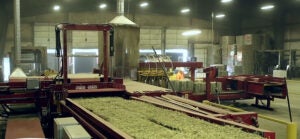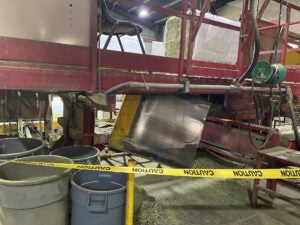Farm machines are huge investments, so cleaning and maintaining them ensures they last a long time. But the deaths of two farm workers in separate hay press incidents demonstrate why it’s also important to follow lockout/tagout (LOTO) procedures and training when cleaning machines.
While hay presses are mainly used in forage processing plants, the safety lessons learned from these tragedies can be applied to any farm machine.
Contact with objects and equipment — which includes being struck, squeezed, pinched, compressed or crushed by machinery — is the second leading cause of work-related deaths in agriculture. From 2015 to 2019, 607 workers died because of such incidents, according to the Bureau of Labor Statistics. These shocking numbers remind us there is much more to be done to improve farm worker safety. For every time a farm worker dies while doing their job, it leaves only heartache for their families and loved ones.
The Washington State Fatality Assessment and Control Evaluation (WA FACE) program at the Washington State Department of Labor & Industries has investigated numerous fatalities involving farm machinery, including the two that occurred while workers were cleaning hay presses or forage compactors.
In the first incident, a 39-year-old hay press operator was struck and killed by the machine’s steel guillotine blade. Near the end of his shift, the plant supervisor asked him and two other workers to clean the machine for maintenance. They started clearing the machine’s main press by pushing a few hay bales on a conveyor toward a covered area that housed a scale and baling and compression chamber. During normal operation, the conveyor moved hay onto the scale. When the hay reached a preset weight, a steel guillotine blade would slice it before the conveyor moved it to be compressed.

The operator was responsible for locking out the energized machine before cleaning it, but he did not do so. Although the conveyor was stopped, the machine was still energized when he crawled unnoticed into the covered area toward the scale and started to push a bale. As he was lying on the scale, the combined weight of his body and the bale caused the guillotine to activate and strike him, resulting in near decapitation. He died at the scene.
In the second incident, a 59-year-old floor sweeper died when he was crushed in a hay press. The sweeper was performing his usual duty of cleaning up hay on the floor around the machine. He was using a broom with an extended handle that let him sweep at a safe distance from the machine’s moving parts.
Just after midnight, the sweeper entered a 10-foot wide opening under the press toward the hay bale elevator. The elevator lowered finished bales from the press, which were then pushed across an output platform for removal and packing.

The elevator was raised five feet above the floor when the sweeper walked under it. Seconds later, the elevator slammed down and pinned his legs and torso. Then, a 1,000-pound bale fell onto the elevator from the ejector above and crushed him facedown for 18 seconds before an automated pusher slid the bale out across his torso.
Three co-workers heard a scream and ran to the elevator. The press operator saw the injured sweeper and shut off the machine. First responders had the workers pull him from the press, but it was too late to save him. Workers told investigators the sweeper knew about the machine’s hazards but did not know why he entered the machine.
What do these tragedies have in common?
So what do these two tragedies have in common? Both involved machines that lacked safeguards to keep workers from entering dangerous areas while the machines were energized. As for the workers, they received ineffective LOTO training that left them unaware of certain hazards and cost them their lives.
There are three lessons to learn from these incidents:
1. Equip farm machines with the best safeguards.
Making sure machines are safe may seem like common sense, but many farmers still don’t pay enough attention to how safe their machines really are for workers who operate them or work nearby. Whether a machine is bought new or used it is vital to look closely at its safety systems for injury prevention features that are missing or need improvement.
One of the best ways to do this is to ask the machine manufacturer or dealer for an in-house consultation or risk assessment to determine the best safeguards and other hazard solutions. Evaluating your machine with the manufacturer may lead to redesigning safety system components; installing additional shields, barriers, and emergency stops; retrofitting older machines with updated safety controls; changing how work is done; or using personal protective equipment (PPE). Consultations are especially important if you have unique, custom-built machines that weren’t sold with supplementary safety manuals.
2. Develop specific LOTO procedures for each machine.
Having a one-size-fits-all LOTO procedure for different machines is asking for serious trouble. Because machines are designed differently, even if they do similar work, are made by the same manufacturer, or appear to have the same hazards, they may require different LOTO procedures to be safely de-energized.
Farmers should have a hazardous energy control program in their accident prevention program (APP) where they can develop clearly written LOTO procedures for each machine. LOTO procedure checklists for each machine can also help ensure workers are shutting down the machine correctly. Energy control programs should also assign distinctly marked or color-coded locks and keys to specific authorized workers, such as supervisors, operators, and mechanics, and require them to fill out danger tags with their name and signature; date, time, and contact information; and details about when and why the LOTO was performed and how long it may be in place.
3. Provide and enforce LOTO training.
This may seem like a no-brainer, but all workers who operate machines or work near them should be trained in LOTO procedures. Training should demonstrate how to perform LOTO procedures strictly according to the machine manufacturer’s requirements. It should also show workers how to identify machine hazards and react to dangerous practices and emergencies. Refresher training should take place before machine cleaning and maintenance. Contact the machine manufacturer or dealer, a professional safety consultant, or local extension service program for help in developing a training plan.
Given the cultural diversity of farm workers, training is more effective when provided in the language workers best understand. Farmers should also take some time to observe workers to be sure they are applying LOTO training properly and consistently. This is especially needed during cleaning, maintenance, and non-routine tasks. Retraining and disciplinary action can be considered as corrective action for workers who repeatedly or intentionally deviate from their training.
Successful farmers value their workers because they see them as their biggest resource. And valuing workers means setting the highest standards for workplace safety. This is a sure way to achieve profitable farms, happy families, and thriving communities.
This article was written by Paul Karolczyk, FACE fatality investigator. Sign up here to receive WA FACE agriculture fatality and injury investigation reports, hazard alerts, data summaries, and shorter form narratives and slideshows.


